Keyword research is a critical step of SEO. Knowing what users type in a search engine will help you create relevant content to satisfy their intent.
When you do this successfully, your pages will start ranking for those search terms and this translates to an increase in SEO traffic.
In this guide, you’ll learn what keyword research is, the keyword research best practices to follow, and how to do keyword research successfully.
What is Keyword Research?
Keyword research is the SEO process of finding out which words or phrases users type into a search engine when looking for information, products, or services on the Internet.
By knowing the exact search terms, you can provide them with relevant content that satisfies their intent.
The outcome of the keyword research process is a list of keywords:
- That can potentially bring you traffic. Trying to rank for keywords that won’t generate website visits is a waste of time and resources.
- That can increase your conversions. In other words, keywords aligned with your business goals to generate sales, leads, or affiliate earnings.
- You can actually rank for. The web is a saturated place, and unfortunately, it’s impossible to rank for all the keywords you want.
You can use the list as the fuel for all your digital marketing campaigns.
Why is keyword research important for SEO?
Keyword research is important for SEO for many reasons:
- If you don’t know the actual search phrases people are using in Google, you risk optimizing your website for the wrong keywords.
- Without analyzing the potential of a keyword, you don’t know if it’s a keyword you want to rank for.
- Without doing research you cannot know for which keywords you can actually rank for and you might be targeting keywords you will never be able to rank well.
- Keyword research will help you understand your industry and identify your true competitors.
- Keyword research will give you a list of keywords to monitor their rankings and evaluate your SEO performance.
- With keyword research, you get to know the size of your potential audience, a metric useful in setting marketing goals and creating growth plans.
Different types of SEO keywords
When doing keyword research, you’ll come across different definitions like ‘seed keywords’, ‘focus keywords’, ‘long-tail keywords’. It will be less confusing to know about the different types of keywords before starting your research.
Seed Keywords – Also known as the head, focus, or main keywords, are usually or two words search phrases that have a high search volume. These keywords are also highly competitive with hundreds of websites competing for one of the top spots in the SERPS.
Here are some examples of seed keywords: ‘SEO’, ‘Social Media’, ‘Online Marketing’, ‘diet’.
Synonyms or closely related keywords – These are keywords closely related to each other. It’s keywords that have the same meaning but written differently.
Here are some examples: ‘how to replace a light bulb’, ‘how to fix a light bulb’, ‘how to change a light bulb’.
Long-tail keywords – Are search phrases consisting of 3 or more words. They have less search volume compared to head keywords but their intent is more specific.
Here are some examples of long-tail keywords: ‘What is SEO’, ‘How to become an SEO Expert’.
Semantically related keywords – also known as LSI keywords, are keywords that are related to each other conceptually.
For example, for the search phrase ‘keyword research’, some semantically related keywords are ‘search volume’, ‘keyword analysis’, ’google keyword tool’.
In this video, you’ll learn two different techniques you can use to perform keyword research and find lucrative keywords for your SEO campaigns.
10 Best Practices to Perform Keyword Research
These are the keyword research steps to follow to find keywords to use in your SEO campaigns.
- Get to know your Niche
- Write down topic ideas and create topic buckets
- Find seed keywords for your topics using keyword research tools
- Examine the search intent of each keyword
- Find long-tail keywords
- Find keywords your competitors are ranking
- Choose the right keywords for your website
- Convert keywords into content titles
- Find Semantically Related Keywords to use in your content
- Keep checking for trending keywords
Step 1: Get to Know your Niche
The first step of the keyword research process is to find out as many details as possible about your niche.
Knowing who you have to compete with, will help you create a realistic keyword list and an SEO strategy that can get you results.
Let’s get started.
Go to Google and start typing search terms related to your niche. Visit all websites that come up on the first page of Google and take note of things like:
- Their posting frequency (how often they update their website with new content)
- Type of content they publish (is it text, videos, etc.)
- How their website is structured (what they have on their homepage, menus, etc.).
- Learn more about their social media presence (channels they are active, how many followers they have, what they are posting, etc.)
- Use tools like SEMRUSH or Ubersuggest to find out their domain authority.
- Register to their newsletter (if they have one) and add them to your Feedly (to get notified of content updates)
The main idea behind this exercise is to identify your main competitors and get new ideas about topics/keywords you can target.
What is important to understand before doing keyword research for SEO purposes, is that there is a big difference between the keywords you would like to achieve high rankings and the keywords you can actually rank high on Google.
If your website is new, some keywords might be impossible to target (usually these are highly competitive keywords), so it’s good to know this from the beginning to adjust your keyword strategy to go after keywords that you have more chances of reaching the first page of Google.
Related Resources
- Best Keyword Research Courses – A list of great courses to improve your keyword research skills.
Step 2: Write down topic ideas and create topic buckets
Once you are done with step 1, it’s time to get more specific by writing down (in a spreadsheet), topic ideas.
Do your brainstorming and write down anything that comes to mind related to your niche, industry, and products.
Put yourself in the position of the Google searcher and try to think what search terms they might type in Google.
If needed, revisit the websites noted in step 1 and take a closer look at their page titles. This can give you more ideas about topics related to your niche that you might have not thought about.
Group your ideas together to form topic buckets. Each topic bucket should include related ideas.
Let me give you an example of how this works.
Let’s say that you are in the digital marketing niche and want to find keywords that can potentially help you get clients for your digital marketing agency.
Your target market is small businesses and startups looking for different kinds of services related to digital marketing.
Your topic buckets might include the following:
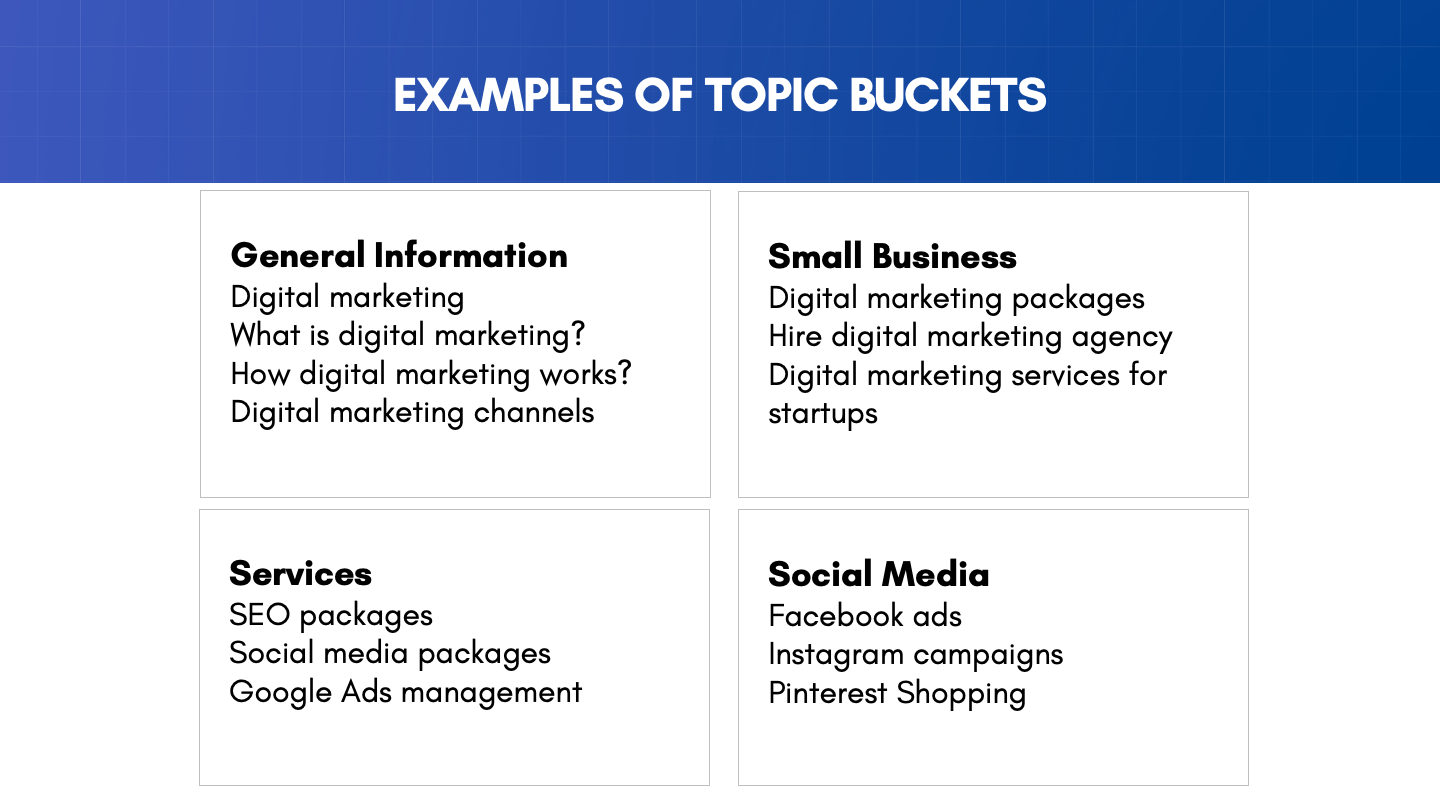
General Information Bucket. This bucket includes ideas related to general questions about digital marketing.
Small Business Bucket. This bucket includes search terms that a small business owner might use in Google when looking for digital marketing agencies.
Services bucket. This bucket includes search terms related to specific marketing services like SEO and social media marketing.
If this is the first time you’re doing keyword research for your website, you may end up having many topic buckets. This is perfectly fine.
Remember that this is an ongoing process and not something you have to complete 100% on the first go.
To begin with, write your basic ideas and move on to the next step.
Step 3: Find seed keywords for your topics using keyword research tools
Now that you have a list of ideas grouped into topic buckets, it’s time to convert your ideas into SEO keywords.
To do that, we need the help of keyword research tools. I will demonstrate the process using SEMRUSH, but you can use your favorite tool to go through the process.
Login to SEMRUSH and go to the KEYWORD MAGIC TOOL.
Take your first topic bucket and start your analysis.
Go through the list and select all keywords related to your business and click the ADD TO KEYWORD MANAGER button.
At this stage, we don’t care about the monthly search volume or Keyword difficulty but to select the most relevant keywords for our website.
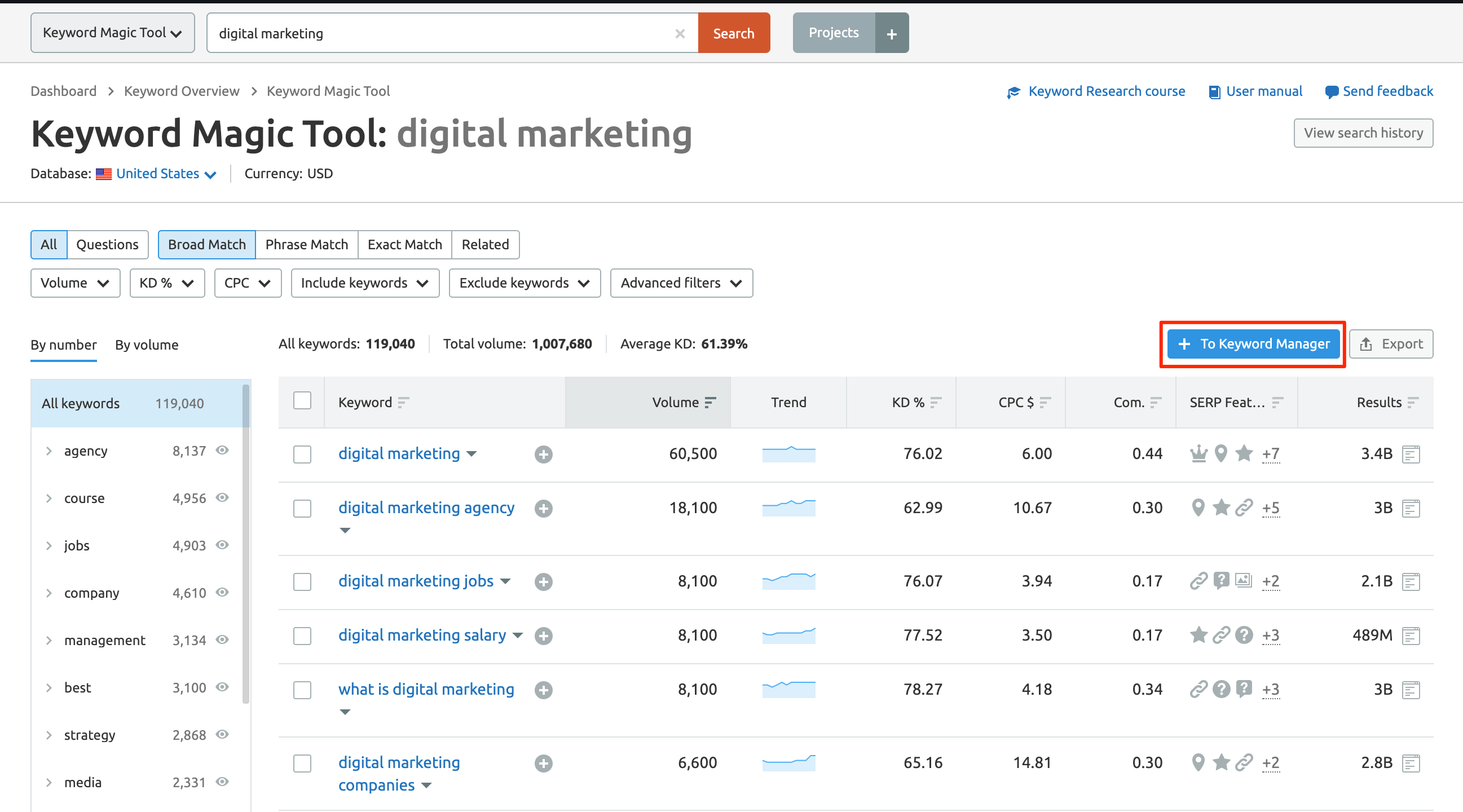
Repeat the process to analyze at least ten ideas from your topic buckets.
When you finish adding keywords to your list, you go to KEYWORD MANAGER to view your selected keywords.
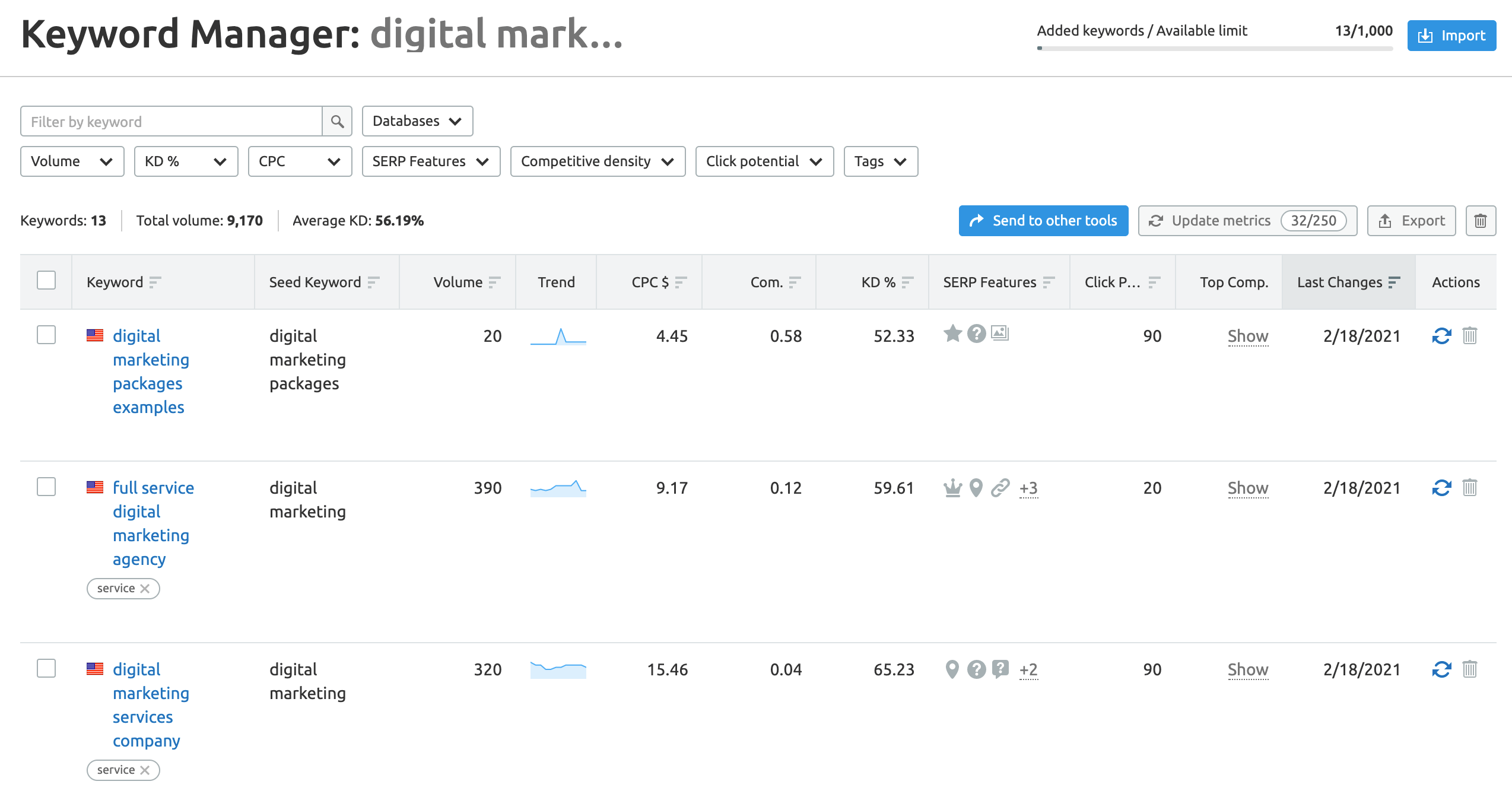
Click the Update Metrics button to refresh the metrics and sort the keywords by volume.
Step 4: Examine the search intent of each keyword
Now that you have a list of seed keywords, it’s time to examine each keyword’s search intent.
For some keywords, the search intent is obvious but for others, it needs more investigation.
For example, when searching for ‘SEO packages for small businesses, their intent is clear, but searching for ‘SEO’ is very vague.
The best way to figure out the search intent of a keyword is to type the keywords in Google and examine the first page of the results.
Google is doing a great job in understanding the user’s actual intent so what they show on the first page, is very close to what users are looking for.
You need to do this exercise to find and eliminate from your list keywords that have a different intent than what you are offering. You don’t want to waste your time targeting keywords that won’t get you the right type of traffic.
For example, I initially added the keyword ‘Freelance Digital Marketing’ to my list.
When you search for this keyword on Google, you will see that most of the results are resources on how to become a freelancer.
Since my goal is to find keywords to get clients, this keyword is not a good fit. The intent of the searcher is not to hire a freelancer but to learn how to become one.
Step 5: Find long-tail keywords
As you work through the list of your seed keywords, you will realize that most of them (if not all), are highly competitive.
In other words, when you search for these keywords on Google, you find hundreds of websites competing for one of the top 10 positions.
If you have an established website, this may not be a very big issue but if you are starting out now, this is a huge problem.
What should you do? Adjust your keyword research strategy and start looking for keywords that are less competitive i.e. long-tail keywords.
Long-tail keywords make up 70% of all searches and it’s your only opportunity to start ranking high on Google for keywords that can bring targeted traffic to your website, in a relatively short amount of time.
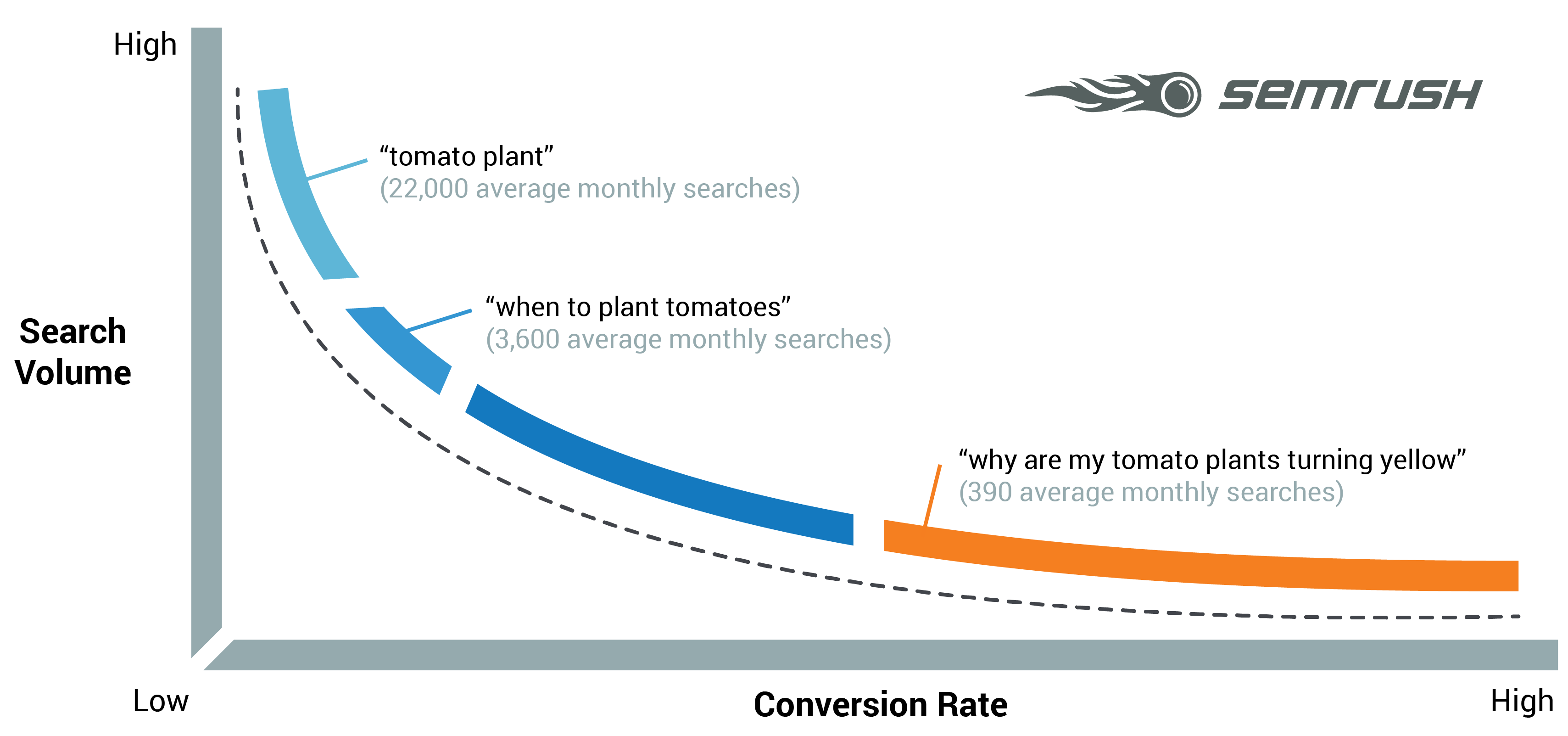
You might think that the issue with long-tail keywords is that they have less search volume and while this is true, less is better than nothing.
In other words, there is no point in spending your time and effort on popular keywords that it’s impossible to rank. Better start with the low-hanging fruit and built your way up.
Once you manage to achieve high rankings for several longtail keywords, you also increase your chances of ranking for seed keywords as well.
How to find long-tail keywords? There are a number of ways to find long-tail keywords.
You can manually search Google and look for the ‘People also ask’ or ‘related searches’ section. You can also go to Wikipedia and Amazon and see what people are searching for.
The fastest way is to use two SEMRUSH functions, the ‘Keyword Magic Tool’ and the ‘Topic Research’ tools.
Revisit the Keyword Magic tool and use the ‘Advanced Filters’ to search for keywords that have 4 words or more. Just enter the number 4 into the ‘Words Count’ box and click Enter.
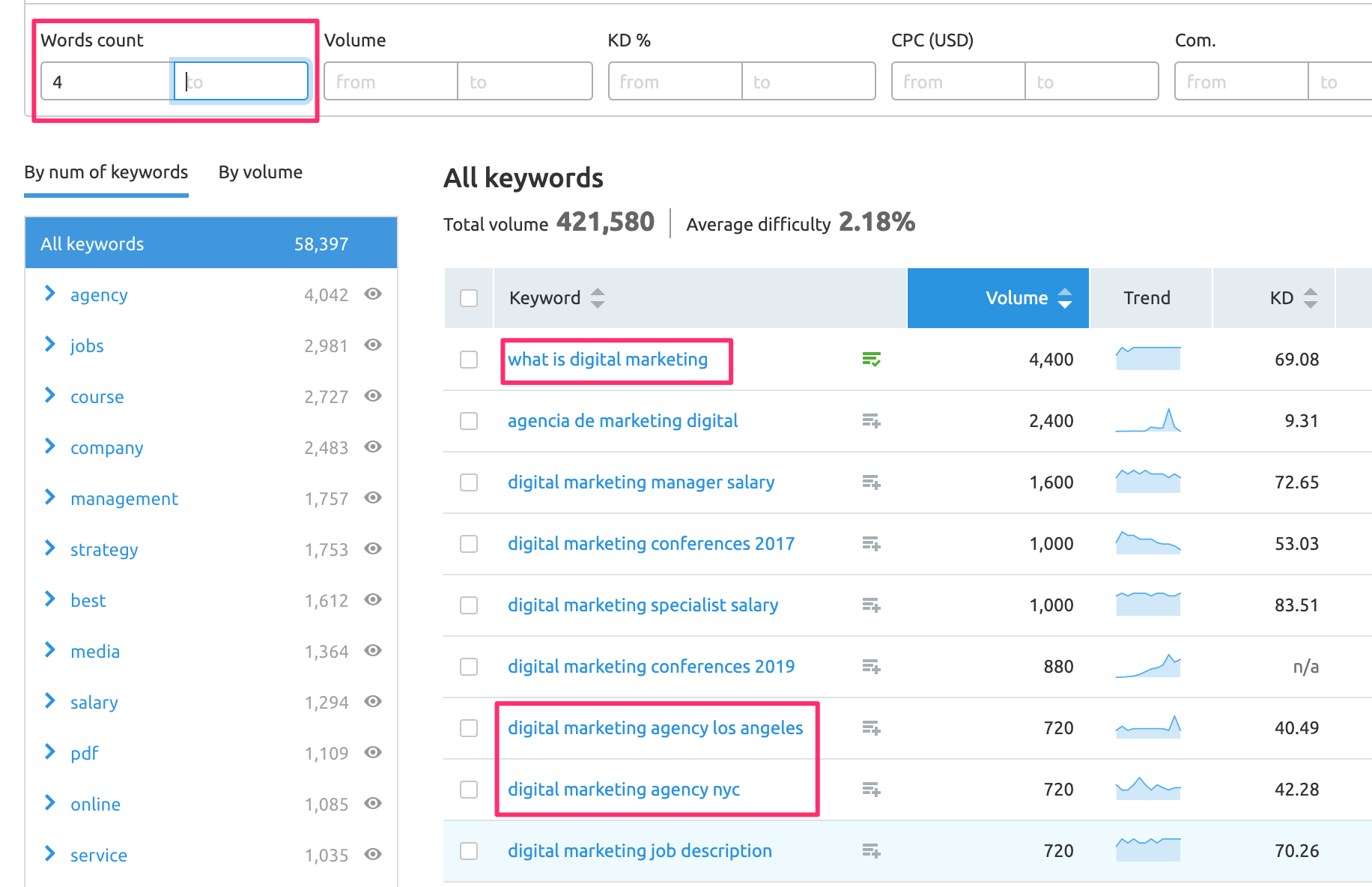
What you see now are keywords that consist of more than 4 words. Select the keywords that match your business, examine their search intent by analyzing the Google results, and add them to your main list.
Another way to find longtail keywords is to use the ‘Topic Research’ tool. Select the topic research option from the menu, type your topic ideas and click GET CONTENT IDEAS.
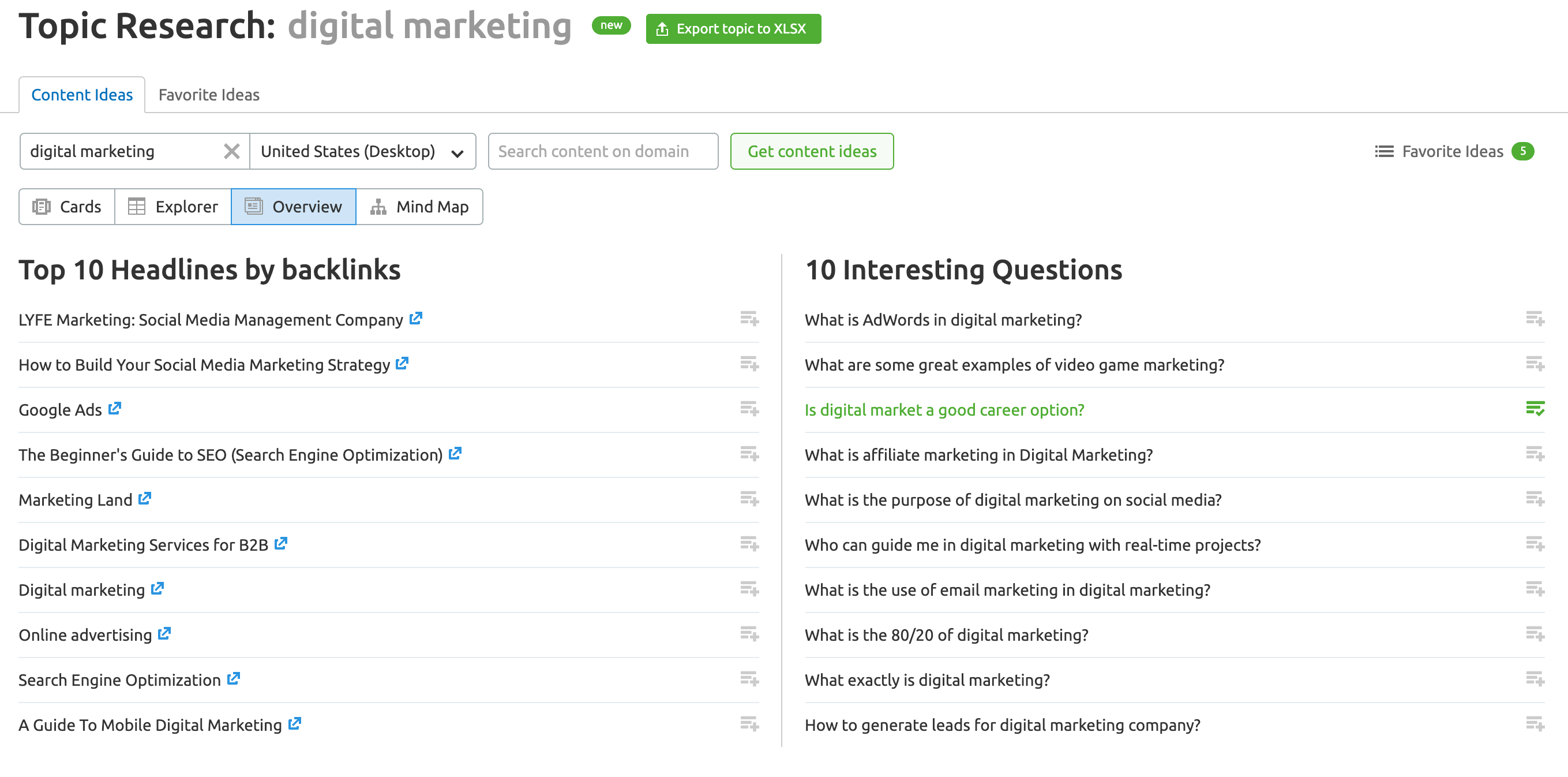
Look for the ‘Interesting Questions’ section and find questions that relate to your business and products.
Step 6: Find keywords your competitors are ranking
While doing your keyword research, you created a list of websites that are your direct competitors. You visited their websites and analyzed their content, now it’s time to learn for which keywords they are actually ranking and the amount of traffic they receive from Google search.
Go to SEMRUSH, select ORGANIC RESEARCH from DOMAIN ANALYTICS, and type in a competitor’s URL.
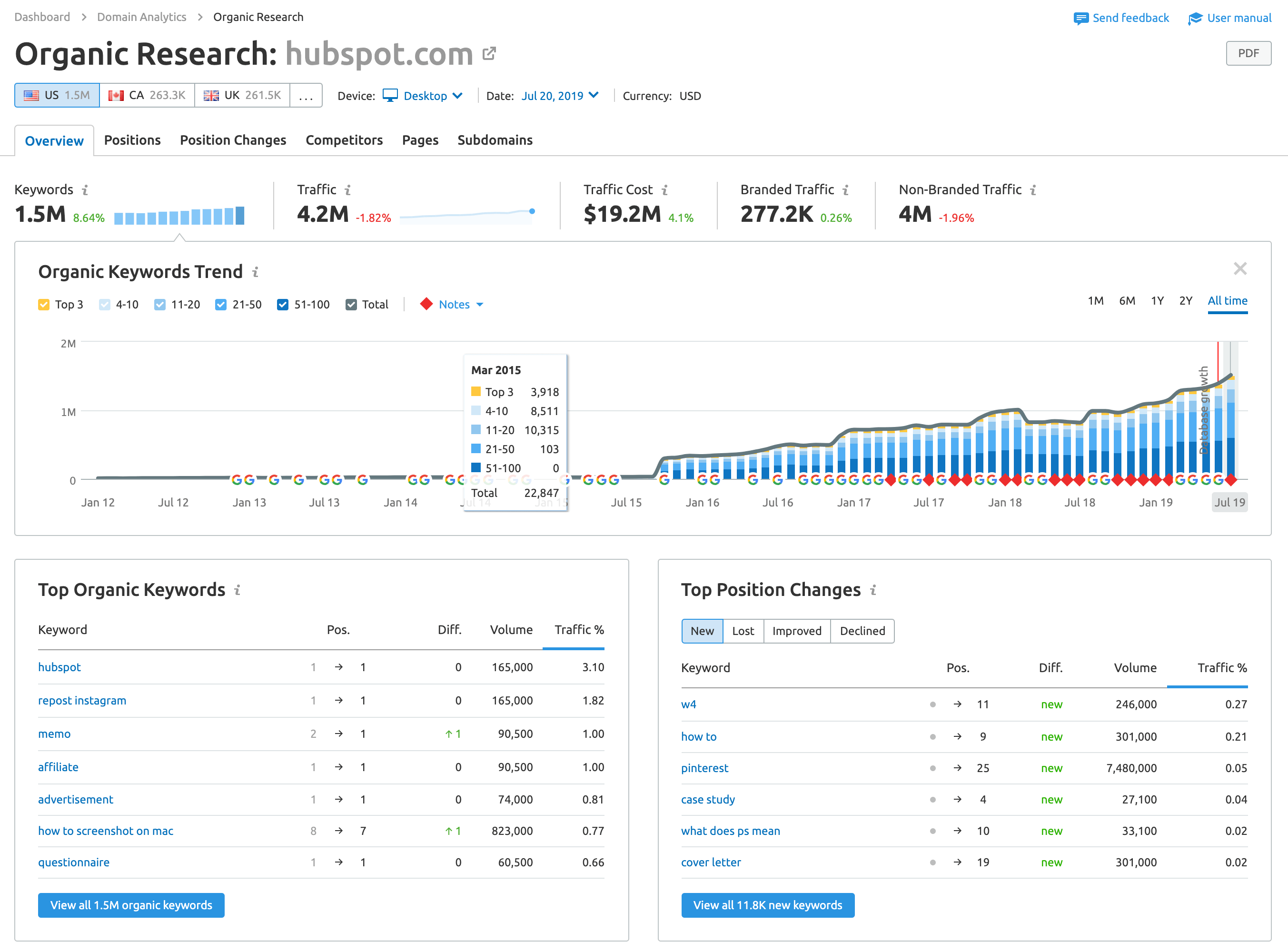
What you see are the keywords your competitors are ranking. Click on VIEW ALL ORGANIC KEYWORDS to go to the full list and use the advanced filters to find keywords with a decent search volume, exclude brand-related keywords and keywords that do not fall into your line of business.
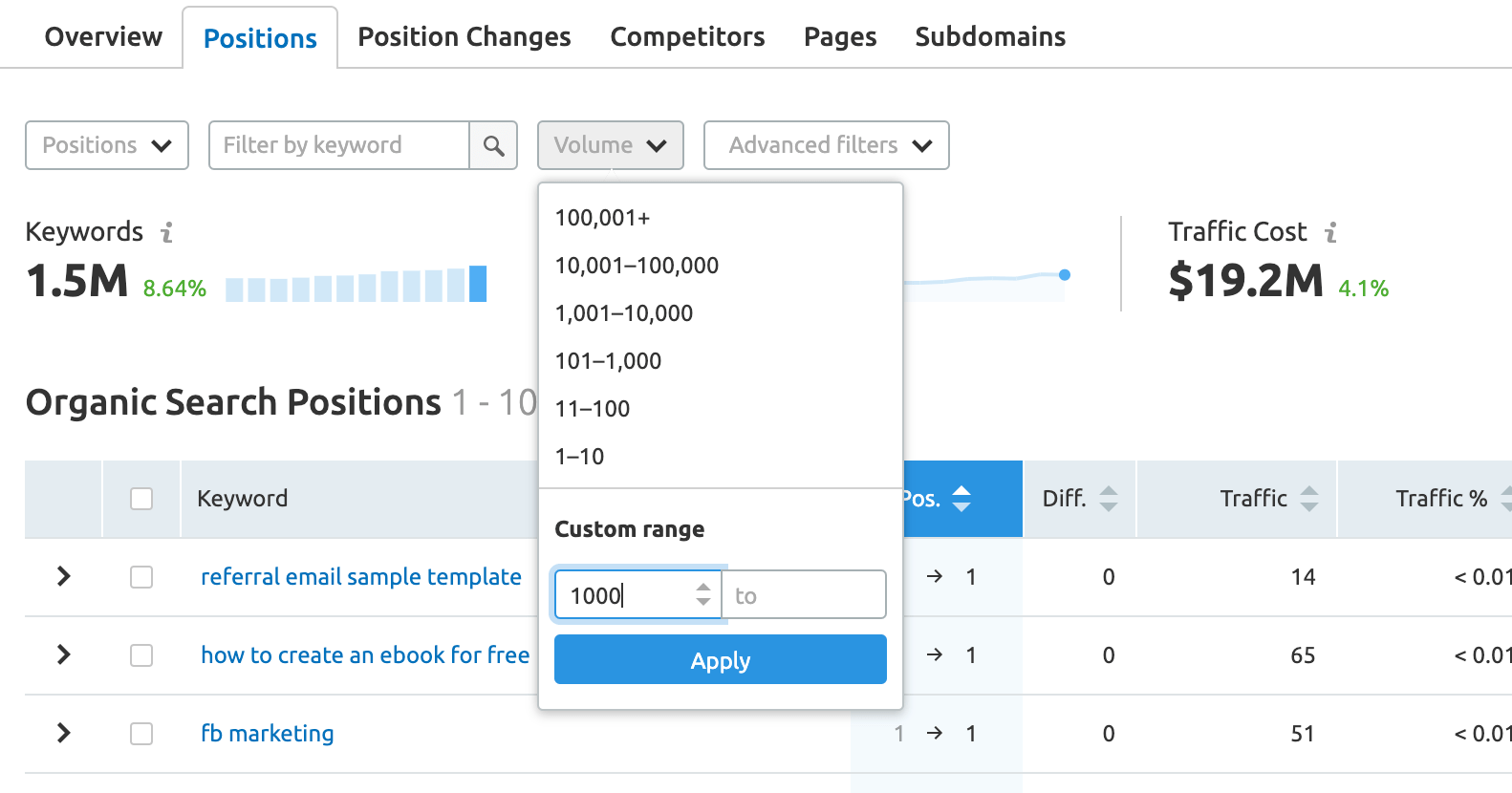
Your goal with this exercise is to find keyword ideas that you might have not thought of before and use them to enrich your keyword list.
You can also follow the above procedure to find out for which specific keywords a competitor’s page is ranking.
In other words, instead of using the domain in the search box, type in the URL of a specific page.
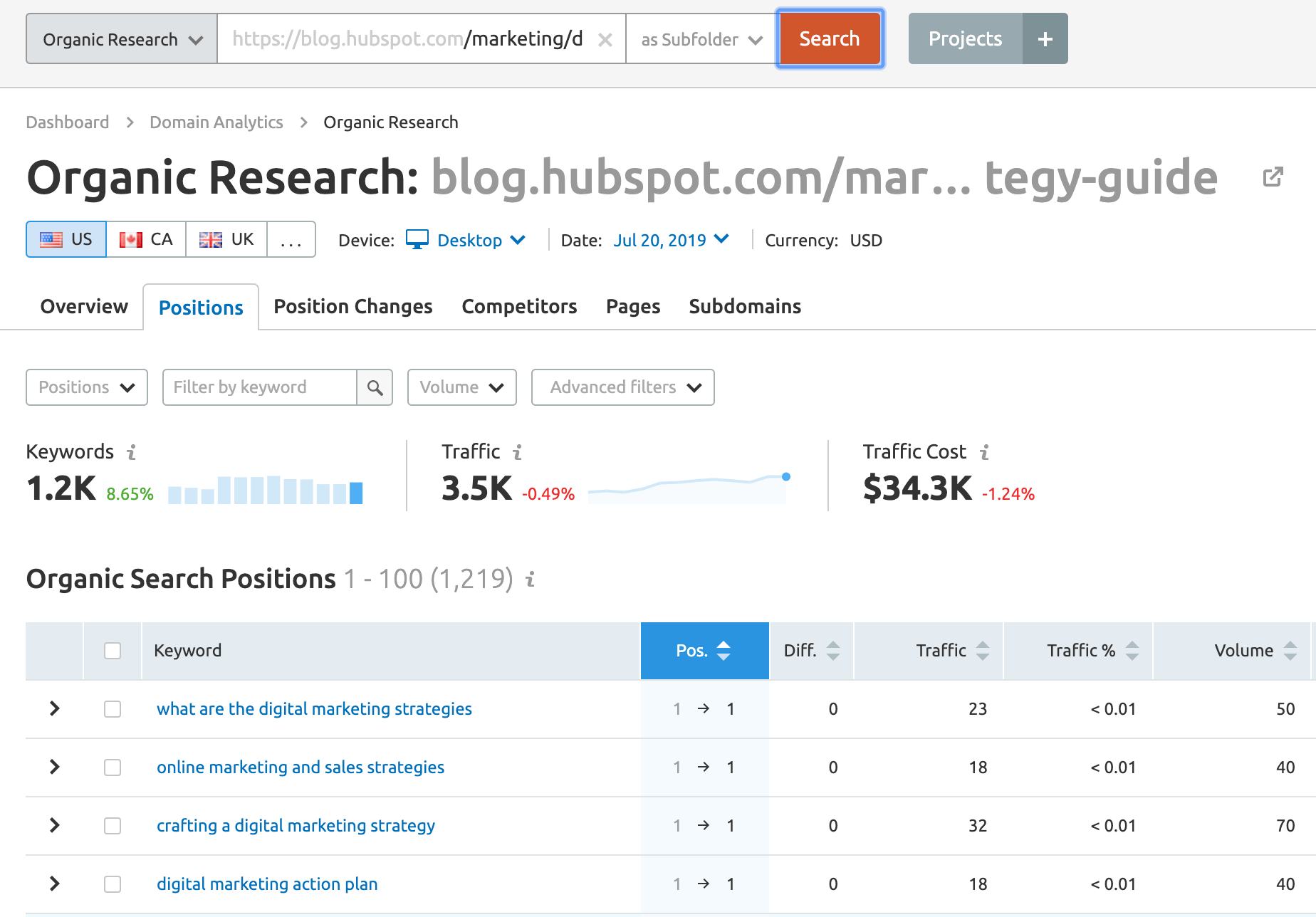
What you see now are all the keywords that the particular page is ranking, the monthly search volume, and whether they generate traffic to the website.
Step 7: Choose the right keywords for your website
Once you reach this point, you should already have a list of keywords (both seed and long-tail keywords), you would like to rank for.
For sure it’s a big list and not easily manageable.
Now it’s time to revise the list once more and narrow it down to 20-30 keywords you can target by either creating SEO optimized landing pages, optimizing your homepage, or creating new pages (blog posts).
To decide, which keywords to keep or discard, we’ll use data gathered so far from the previous steps and add two more parameters to the mix, keyword difficulty, and authority of the domains ranking on the first page of Google.
What is keyword difficulty?
It is an estimate of how difficult it would be to rank well in Google organic search for that keyword. It is given as a percentage, the higher the percentage the more difficult is to rank high for the specific keyword.
Each tool has its own way of calculating keyword difficulty but in general the lower the value, the better.
In all SEMRUSH reports, you can see the keyword difficulty of a keyword, the column is marked as KD%.
Authority of domains ranking on the top positions
I’ve mentioned this a couple of times so far but it’s time to make it more specific.
When you search for a keyword on Google and you notice that the first 10 positions are occupied by big and well-known websites, it means that it is very difficult for a small business website or blog to get there.
For example, if you search for ‘Digital Marketing’ you’ll see websites like HubSpot, Moz, Wikipedia, and other giant websites.
This means that although ‘digital marketing’ is a term I would like to rank for, Google tells me that this is not possible so I take that term out of my list and instead look for variations (long-tail search terms) that are possible to target.
How to decide which keywords are the correct keywords to target
Go through the keywords one by one and decide whether to keep or remove them from your list, by answering the following questions:
- Is the keyword search intent in-synch with your marketing goals?
- Is the keyword difficulty low compared to other keywords?
- Does Google rank normal websites in the first 10 positions or is it only big and well-known websites?
- Is there a decent search volume (above 50) for that keyword?
- Can you provide good content for that keyword?
If the answer to all the questions is YES, then keep that keyword in your list, otherwise if the answer to any of the above is NO, remove it from your list.
If at the end of this exercise, you have a short keyword list, you need to go back and repeat all keyword research steps and find more keywords to enrich your list.
Remember that the goal of keyword research is not to create a long list of keywords that you will not use but to create a list of keywords that you can actually use in your content marketing campaigns.
Step 8: Convert keywords into page titles
Once you reach this point you can relax, the difficult part is behind you. Now, it’s time to convert those keywords into page titles and write the content.
Why pay attention to your page titles?
Good SEO best practices indicate that each page or post on your website should target a specific keyword only.
There is too much content on the Internet and Google tries to pick up the 10 best pages for a particular keyword.
To help them in this process, you need to make sure that each page is focusing on a specific keyword and that this is reflected in your page titles.
To convert keywords into page titles, follow these simple rules:
- Search for the keyword on Google and examine the first 10 page titles
- Create a title that contains your target keyword but make it unique i.e. Make sure that it’s not the same as one of the titles that are already shown on the first page. You need to do this because Google rarely shows pages with the same titles in the SERPS.
- Make your title interesting by adding powerful words (like Amazing, complete, easy, etc.)
Step 9: Find Semantically Related Keywords to use in your content
Now that you have your titles ready the next step is to create high-quality SEO-friendly content.
One of the things that you need to consider is semantically related keywords.
Semantically related keywords (or LSI keywords) are keywords related to your target keywords or keywords that have the same meaning.
By adding these keywords to your content, you make the content more relevant to search engines and this dramatically increases your chances of ranking for your main keyword.
You can use SEMRUSH to find RELATED keywords (by clicking the RELATED button as shown below) or if you don’t have a SEMRush subscription, you can use tools like LSI Graph.
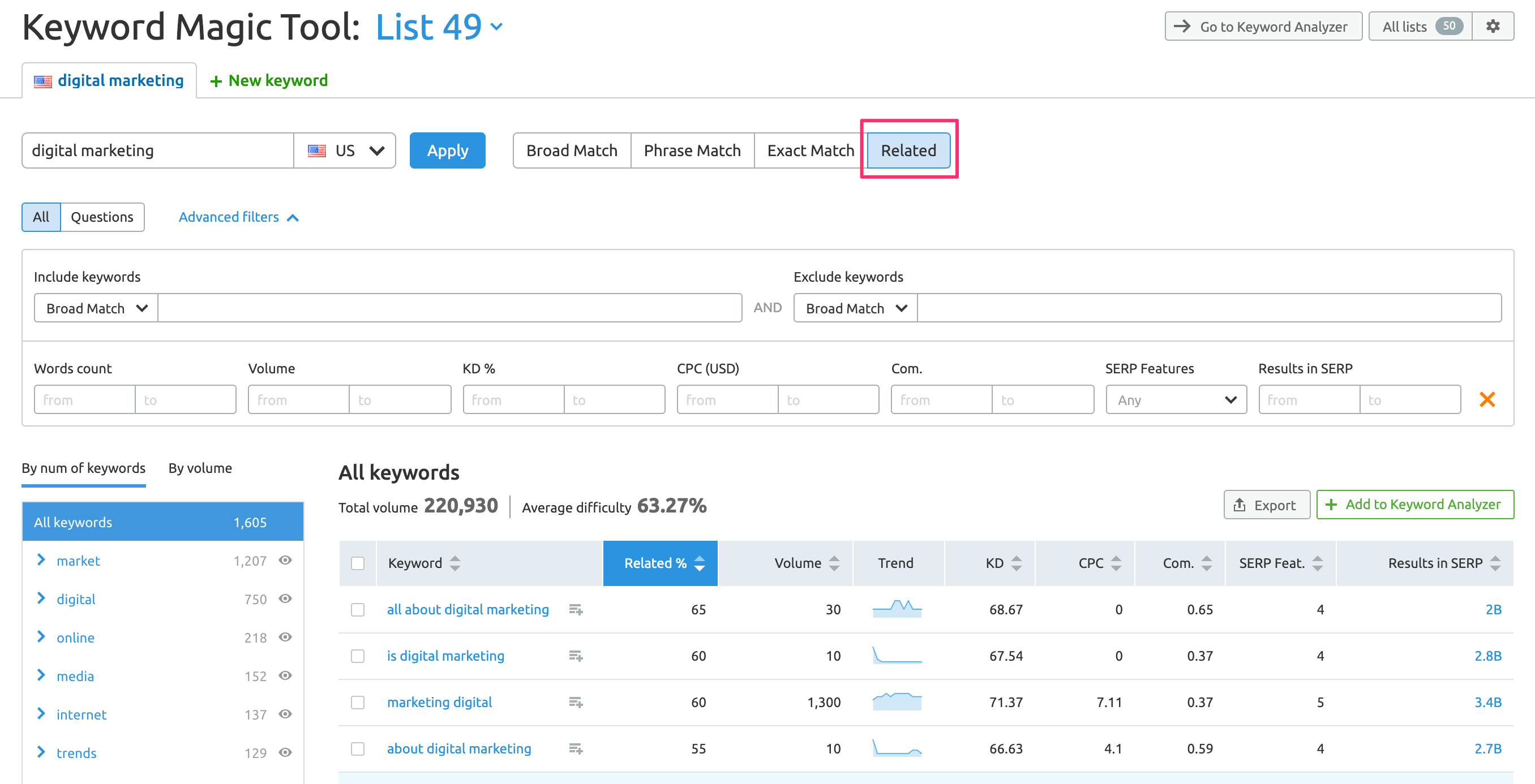
While optimizing your content for SEO, make sure that you add these keywords to your copy.
Step 10: Keep checking for trending keywords
Besides the above steps, you also need to monitor your niche for trending keywords and new keywords that rise to the surface.
It’s a fact that 30% of the queries entered into Google on a monthly basis are NEW and keywords that Google has never seen before.
This means that the keywords tools won’t show a big search volume for these keywords or not show them at all.
Most probably it’s keywords your competitors are not aware of, so this gives you a competitive advantage since you can rank for them faster.
I personally use this method a lot and it works great for almost all niches and industries.
Google Trends is the tool to use for this exercise. Go to Google Trends and enter your seed keywords.
Filter the results by area (if you are targeting specific areas), by categories, and Google search channel.
Look for the RELATED QUERIES section and drill down to get more details for a specific query.
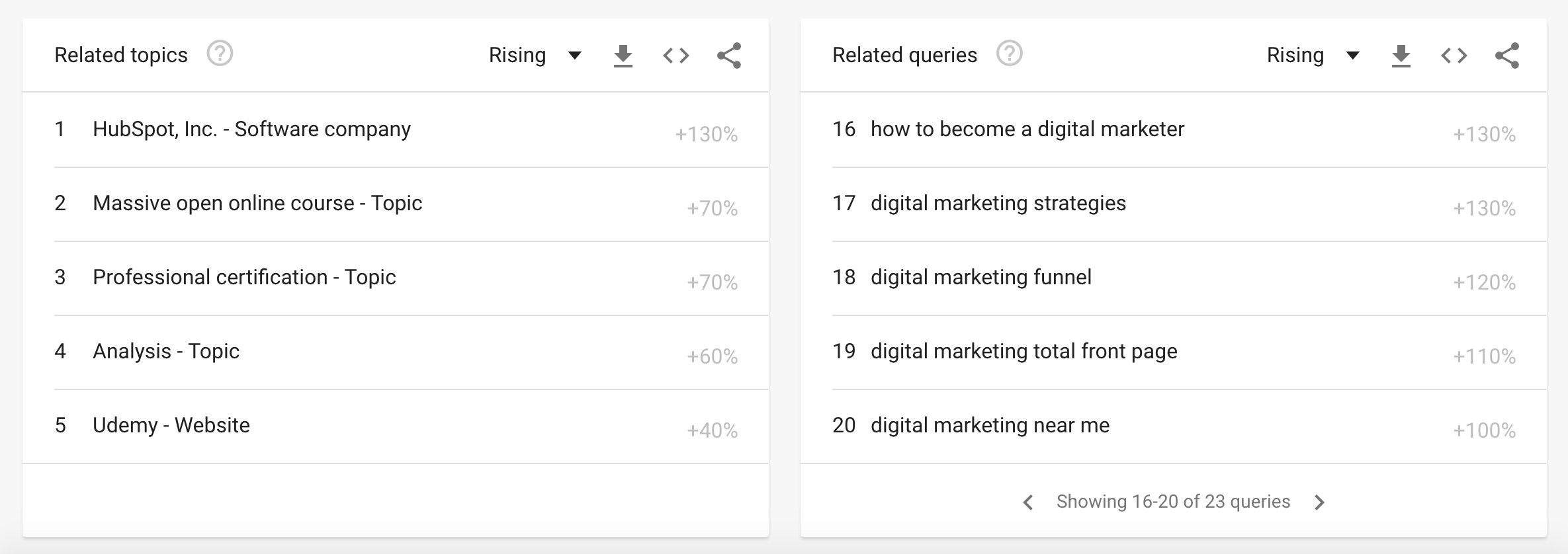
A piece of advice, don’t give up too soon on this tool, try different filters and different keywords/topics and you can find some great keywords to target before everyone else does.
Add in your calendar a reminder to repeat this exercise at least once every 3 months.
How to use keywords in your content
Besides using your target keyword in the page title and adding LSI keywords within your content, there are a few other places where you need to add your keywords.
This is explained in detail in the SEO writing guide, the most important guidelines are:
- Use your focus keyword in the page title – as explained above
- Use your focus keyword in the page URL
- Use your focus keyword in the page title tag and H1 tag
- Use Long-tail keywords in your H2 and H3 headings
- Use related keywords in the image ALT Text
- Use related keywords and synonyms in your copy
- Use LSI keywords in the content (as explained above).
Keyword Research Tools to Use
To perform keyword research, you need the help of tools. There is a lot of data to analyze and it’s impossible to do it manually.
These are the tools that I use and recommend.
SEMRUSH (Paid)

This is my favorite tool for keyword research and the tool I use on a daily basis for all digital marketing tasks. It’s not free, it comes with a monthly subscription but worth’s every cent.
For keyword research, you can use SEMRUSH to do topic research, find out seed keywords, long-tail keywords, and related keywords.
If you don’t already have a subscription with an SEM tool, then SEMRUSH is the way to go.
Before selecting SEMRUSH, I have tested a number of other tools but none of them has the functionality of SEMRUSH at this price range.
You can register for a 14-Day free trial and test it yourself.
Google Keyword Tool (Free)

The Google keyword tool is a free tool provided by Google that allows you to do keyword research for PPC (Google Ads) purposes but you can also use it to do keyword research for SEO.
The tool is free but in order to use it, you need to have an active Google Ads account.
Go to Google Ads and register for a free account. Then, create a Google Ads campaign but do not activate it, keep it paused, and access the tool by selecting TOOLS and then KEYWORD PLANNER.
UberSuggest (Free)

Another free keyword research tool that is worth exploring is Ubersuggest. You can use it to do both topic and keyword research.
While the tool is free, the only disadvantage is that it does not allow you to create an account to save your reports or keywords and this means that every time you want to do keyword research, you need to start from the beginning.
This is not the case with SEMRUSH, where you have an account and all your lists/data saved and always accessible.
Google Search Console (Free)

While the primary function of the Google search console is to optimize your website for technical SEO, it’s the tool to use to optimize your pages after they are published.
Keyword research is an on-going process and the best tool to use to find out the actual keywords your pages are ranking is the Google Search console.
Why this is an important step? When you optimize a page for a keyword, it does not always go as planned.
Google may rank the page for different keywords and the way to ‘correct this’ is to find out for which keywords the page has more chances of ranking and add those keywords in your content.
Here are the steps to follow:
- Create an account and verify your website.
- Access the ‘Search Performance Report’
- Look at the ‘search terms’ and ‘positions’ columns
- Identify keywords that are not included in your content.
- Change your content to naturally add those keywords
- Re-submit your page to Google.
Google Trends (Free)

As explained above, another tool you can use to find out about new and trending keywords is Google Trends.
Go to Google Trends and perform several searches, using different filters to find out what is trending in your industry.
Key Learnings
Keyword research is an important process of SEO. Through keyword research, you can find the keywords that really matter for your business and use them in your SEO and content marketing campaigns.
Keyword research is not a once-off process but it’s an ongoing process. You do it initially when you start a new website or SEO campaign and depending on the results, you need to go back and revise your keywords list.
The process is simple but it’s time-consuming. As your website grows you will need to find more keywords to target and this is the part that is becoming more challenging.
You cannot do keyword research without the help of tools. While you can use free tools like the Google Keyword Planner and Ubersuggest, for long-term projects you need the help of more reliable tools like SEMRUSH or Ahrefs.
Finally, if you already have an existing website with rankings then don’t forget to use the Google search console when doing keyword research.
Through the GSC you can learn which keywords bring Google traffic to your website now and which keywords Google believes are a good fit for your website and content.





Hi!
The way you discussed what is the best keyword research for SEO is really awesome. The methods you showed were also extraordinary and helpful.
Thanks
Hi Mustakin
Thanks a lot for your comment. All the best with your keyword research efforts.
Alex
This complete guide is very useful and easy to understand. Keyword strategy shared by you is very helpful to find the relevant keyword for PPC campaign.